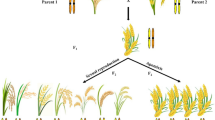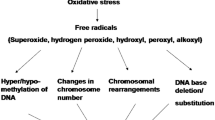Abstract
Difficulties in obtaining new breeding lines of Brachiaria (Trin.) Griseb., an important forage grass in Brazil, are mostly related to differences in ploidy among the accessions, and to apomixis, an asexual mode of reproduction. Usually, sexual accessions are diploid while apomicts are polyploid. Induced tetraploids of Brachiaria brizantha (A. Rich.) Stapf have been successfully obtained and this paper presents the results of a study of their reproductive modes and fertility. Despite frequent meiotic aberrations during microspore development, the induced tetraploids produced viable pollen and produced progeny after controlled self-pollination. Similarly to the original diploid sexual progenitor, embryo sacs of the Polygonum type with confirmed meiotic origin were present in the induced tetraploids suggesting chromosome doubling did not alter the reproductive mode. The embryo sac of the Polygonum type was also observed in progenies obtained after self and open pollination. Nevertheless, embryo sacs of the Polygonum and the Panicum types within the same ovule were observed in some progenies obtained after open pollination, probably having resulted from hybridization with tetraploid, apomictic plants. Indeed, the compatibility of the progeny with tetraploid, apomictic B. brizantha was confirmed by the formation of mature caryopses after controlled pollination. Evidence is presented that the induced tetraploids and their progeny are sexual plants and that they are compatible with natural tetraploid B. brizantha. The induced tetraploids will be useful for analyses of apomictic inheritance as well as in the development of sexual tetraploid lines in Brachiaria breeding programs.
Similar content being viewed by others
References
Alves, E.R., 2000. Biologia reprodutiva de Brachiaria brizantha cv. Marandu. M.Sc. Thesis. University of Brasília, Brasília-DF, Brazil, p. 94.
Alves, E.R., V.T.C. Carneiro & A.C.G. Araujo, 2001. Direct evidence of pseudogamy in an apomictic Brachiaria brizantha (Poaceae). Sex Plant Reproduc 14: 207–212.
Asker, S.E. & L. Jerling, 1992. Apomixis in Plants, CRC Press Inc., Boca Raton, FL.
Araujo, A.C.G., S. Mukhambetzhanov, M.T. Pozzobon, E.F. Santana & V.T.C. Carneiro, 2000. Female gametophyte development in apomictic and sexual Brachiaria brizantha (Poaceae). Rev Cytol Biol Veg – Le Botaniste Tome XXIII: 13–28.
Bicknell, R.A., N.K. Borst & A. Koltunow, 2000. Monogenic inheritance of apomixis in two Hieracium species with distinct developmental mechanisms. Heredity 84: 228–837.
Bicknell, R.A. & A.M. Koltunow, 2004. Understanding apomixis: Recent advances and remaining conundrums. Plant Cell 16: S228–S245.
Carman, J.G., 1997. Asynchronous expression of duplicate genes in angiosperms may cause apomixis, bispory, tetraspory, and polyembryony. Biol J Linn Soc 61: 51–94.
Carnahan, H.L. & H.D. Hill, 1958. Apomxis in the Gramineae: Panicoideae. Am J Bot 54: 253–253.
Dusi, D.A.A. & M.T.M. Willemse, 1999. Apomixis in Brachiaria decumbens Stapf.: Gametophytic development and reproductive calendar. Acta Biol Cracov Soc Bot 41: 151–162.
Dusi, D.M.A. & M.T.M. Willemse, 1999b. Activity and localisation of sucrose synthase and invertase in ovules of sexual and apomictic Brachiaria decumbens. Protoplasma 208: 173–185.
Gobbe, J., A. Swenne & B.-P. Louant, 1982a. Diploïdes naturels et autotetraploïdes induits chez Brachiaria ruziziensis Germain et Evrard: criteres d' identification. Agron Trop 36: 339–346.
Gobbe, J., B. Longly & B.-P. Louant, 1982b. Calendrier des sporogénèses et gamétogénèses femelles chez le diploïde et le tétraploïde induit de Brachiaria ruziziensis (Graminée). Can J Bot 60: 2032–2036.
Hopkinson, J.M., F.H.D. de Souza, S. Diugheroff, A. Ortiz & M. Sanchez, 1996. Reproductive physiology, seed production, seed quality of Brachiaria. In: J.W. Miles, B.L. Maass & C.B. do Valle (Eds.), Brachiaria: Biology, Agronomy, and Improvement, pp. 124–140. CIAT, Colombia.
Koltunow, A.M. & U. Grossniklaus, 2003. Apomixis: A developmental perspective. Ann Rev Plant Biol 54: 547–574.
Lutts, S., J. Ndikumana & B.-P. Louant, 1994. Male and female sporogenesis and gametogenesis in apomictic Brachiaria brizantha, Brachiaria decumbens and F1 hybrids with sexual colchicine induced tetraploid Brachiaria ruziziensis. Euphytica 78: 19–25.
Leblanc, O., M. Dueñas, M. Hernández, S. Bello, V. Garcia, J. Berthaud & Y. Savidan, 1995. Chromosome doubling in Tripsacum: The production of artificial, sexual tetraploid plants. Plant Breed 114: 226–230.
Macedo, M.C.M., 1995. Pastagens no ecossistema cerrados: Pesquisas para o desenvolvimento sustentável. Proceedings of the Simpósio sobre pastagens nos ecossistemas brasileiros: Pesquisas para o desenvolvimento sustentável, Brasília-DF pp. 28–62.
Miles, J.W. & M.L. Escandon, 1997. Further evidence on the inheritance of reproductive mode in Brachiaria. Can J Plant Sci 77: 105–107.
Miles, J. & C.B. do Valle, 1996. Manipulation of apomixis in Brachiaria breeding. In: J.W. Miles, B.L. Maass & C.B. do Valle (Eds.), Brachiaria: Biology, Agronomy, and Improvement, pp. 147–163. CIAT, Colombia.
Ndikumana, J., 1985. Étude de l'hibridation entre espèces apomitiques et sexuées dans le genre Brachiaria. Ph.D. Thesis, Louvain-la-Neuve, Universitè de Louvain, Belgium. p. 210.
Ngendahayo, M., 1988. Mécanismes de la réproduction dans le genre Brachiaria Gris. et stratégies d'amélioration et de séléction. Université Catholique de Louvain. Belgium. Ph.D. Thesis, p. 165.
Nogler, G.A., 1984. Gametophytic apomixis. In: B.M. Johri (Ed.), Embriology of Angiosperms, pp. 475–518. Springer-Verlag, Berlin.
Penteado, M.I.O., A.C.M. Santos dos, J.F. Rodrigues, C.B. Valle do, M.A.C. Seixas & A. Esteves, 2000. Determinação de ploidia e quantidade de DNA em diferentes espécies do gênero Brachiaria. Boletim de Pesquisa 11 p. 31, Campo Grande: Embrapa-CNPGC.
Pinheiro, A.A., M.T. Pozzobon, C.B. Valle, M.I.O. Penteado & V.T.C. Carneiro, 2000. Duplication of the chromossome number of diploid Brachiaria brizantha plants using colchicine. Plant Cell Rep 19: 274–278.
Pozzobon, M.T. & A.C.G. Araújo, 1998. Técnica de clareamento modificada na análise de sacos embrionários em Brachiaria e Paspalum (Gramineae) através da microscopia interferencial. Boletim de Pesquisa 3, p. 17. Brasília: Embrapa Recursos Genéticos e Biotecnologia.
Quarin, C.L., F. Espinoza, E.J. Martinez, S.C. Pessino & O.A. Bovo, 2001. A rise of ploidy level induces the expression of apomixis in Paspalum notatum. Sex Plant Reproduc 13: 243–249.
Quarin, C.L. & W.W. Hanna, 1980. Effect of three ploidy levels on meiosis and mode of reproduction in Paspalum hexastachyum. Crop Sci 20: 69–75.
Quarin, C.L., G.A. Norrmann & F. Espinoza, 1998. Evidence for autoploidy in apomictic Paspalum rufum. Hereditas 129: 119–124.
Rodrigues, J.C.M., G.B. Cabral, D.M.A. Dusi, L.V. Mello, D. Rigden & V.T.C. Carneiro, 2003. Identification of differentially expressed cDNA sequences in ovaries of sexual and apomictic plants of Brachiaria brizantha. Plant Molec Biol 53: 745–757.
Savidan, Y., 1982. Nature et heredité de l'apomixie chez Panicum maximum Jacq. Travaux et Documents de L'ORSTOM. 153, p. 159.
Savidan, Y., 2000. Apomixis: Genetics and breeding. Plant Breed Rev 18: 13–86
Sheerwood, R.T., C.C. Berg & B.A. Young, 1994. Transfering apomixis to maize. In: G.S. Khush (Ed), Apomixis: Exploiting Hybrid vigour in Rice, pp. 23–29. International Rice Research Institute, Manila, Phillippines.
Swenne, A., B.-P. Louant & M. Dujardin, 1981. Induction par la colchicine de formes autotetraploïdes chez Brachiaria ruziziensis Germain et Evrard (Graminée). Agron Trop 36: 134–141.
Tucker, M.R., A.C.G. Araujo, N. Paech, V. Hecht, E.D.L. Schmidt, J.-B. Rossel, S.C. De Vries & A.M.G. Koltunow, 2003. Sexual and apomictic reproduction in Hieracium subgenus Pilosella are closely interrelated developmental pathways. Plant Cell 15: 1524–1537.
Valle, C.B. do, 1986. Cytology, mode of reproduction and forage quality of selected species of Brachiaria Griseb. Ph.D. Thesis, University of Illinois, IL, 90 p.
Valle, C.B. do, 1990. Coleção de germoplasma de espécies de Brachiaria no CIAT: Estudos básicos visando ao melhoramento genético. Documentos 46 p.33. Campo Grande: Embrapa – CNPGC.
Valle, C.B. do & C. Glienke, 1991. New sexual accessions in Brachiaria. Apo News l 3: 11–13.
Valle, C.B. do, C. Glienke & G.O.C. Leguizamon, 1994. Inheritance of apomixis in Brachiaria, a tropical forage grass. Apo News l 7: 42–43.
Valle, C.B. do & Y. Savidan, 1996. Genetics, cytogenetics and reproductive biology of Brachiaria. In: J.W. Miles, B.L. Maass & C.B. do Valle (Eds.), Brachiaria: Biology, Agronomy, and Improvement, pp. 147–163. CIAT, Colombia.
Voigt, P.W. & B.L. Burson, 1981. Breeding of apomictic Eragrostis curvula. 14th International Grasslands Congress. Lexington Ky. pp. 160–163.
Author information
Authors and Affiliations
Corresponding author
Rights and permissions
About this article
Cite this article
Araujo, A.C.G., Nóbrega, J.M., Pozzobon, M.T. et al. Evidence of sexuality in induced tetraploids of Brachiaria brizantha (Poaceae). Euphytica 144, 39–50 (2005). https://doi.org/10.1007/s10681-005-2842-2
Received:
Accepted:
Issue Date:
DOI: https://doi.org/10.1007/s10681-005-2842-2




